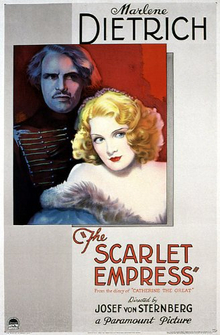
Catherine II, most commonly known as Catherine the Great, was the reigning empress of Russia from 1762 to 1796. She came to power after overthrowing her husband, Peter III. Under her long reign, inspired by the ideas of the Enlightenment, Russia experienced a renaissance of culture and sciences, which led to the founding of many new cities, universities, and theatres, along with large-scale immigration from the rest of Europe and the recognition of Russia as one of the great powers of Europe.

Elizabeth or Elizaveta Petrovna was Empress of Russia from 1741 until her death in 1762. She remains one of the most popular Russian monarchs because of her decision not to execute a single person during her reign, her numerous construction projects, and her strong opposition to Prussian policies.
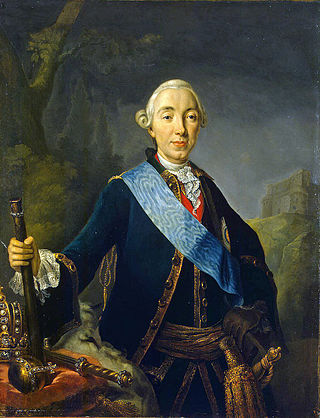
Peter III Fyodorovich was Emperor of Russia from 5 January 1762 until 9 July of the same year, when he was overthrown by his wife, Catherine II. He was born in the German city of Kiel as Charles Peter Ulrich of Schleswig-Holstein-Gottorp, the grandson of Peter the Great and great-grandson of Charles XI of Sweden.
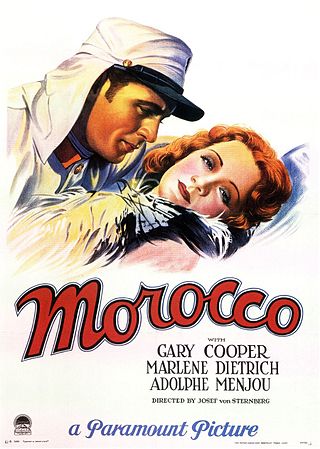
Morocco is a 1930 American pre-Code romantic drama film directed by Josef von Sternberg and starring Gary Cooper, Marlene Dietrich, and Adolphe Menjou. Based on the 1927 novel Amy Jolly by Benno Vigny and adapted by Jules Furthman, the film is about a cabaret singer and a Legionnaire who fall in love during the Rif War, and whose relationship is complicated by his womanizing and the appearance of a rich man who is also in love with her. The film is famous for a scene in which Dietrich performs a song dressed in a man's tailcoat and kisses another woman, both of which were considered scandalous for the period.

Anna Leopoldovna, born Elisabeth Katharina Christine von Mecklenburg-Schwerin and also known as Anna Carlovna, was regent of Russia for just over a year (1740–1741) during the minority of her infant son Emperor Ivan VI.

Josef von Sternberg was an American filmmaker whose career successfully spanned the transition from the silent to the sound era, during which he worked with most of the major Hollywood studios. He is best known for his film collaboration with actress Marlene Dietrich in the 1930s, including the highly regarded Paramount/UFA production The Blue Angel (1930).

Count Alexei (Alexey) Grigoryevich Orlov-Chesmensky was a Russian soldier, general-in-chief, general admiral and statesman, who rose to prominence during the reign of Catherine the Great. His joint victory with Grigory Spiridov and Samuel Greig in the Battle of Chesma put him in the ranks of the outstanding Russian military commanders of all time; and although he lacked naval experience, he was the only authority in those circumstances who could ensure proper co-ordination of action.
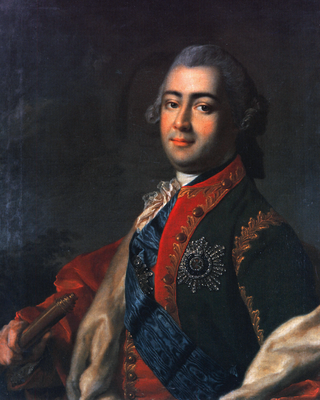
Count Alexei Grigorievich Razumovsky was a Ukrainian-born Russian Registered Cossack who rose to become the lover, and it was suggested he was the morganatic spouse, of Empress Elizabeth Petrovna of Russia. A member of the House of Razumovsky, he survived Elizabeth. The matter of any children they may have had together is unresolved.

The House of Orlov is the name of a Russian noble family which produced several distinguished statesmen, scientists, diplomats, and soldiers. The family first gained distinction in the 18th century through the achievements of five Orlov brothers, of whom the second eldest was Catherine the Great's paramour, and two younger brothers were notable military commanders.

Princess Tarakanova was a pretender to the Russian throne. She styled herself, among other names, Knyazhna Yelizaveta Vladimirskaya, Fräulein Frank, and Madame Trémouille. Tarakanova is a later name, used only in entertainment, apparently on the basis of her relatives being the owners of the estate Daraganovka (Tarakanovka) in Ukraine - the place where she (apparently) grew up. In her own time, she was not known by that name.

The Devil Is a Woman is a 1935 American romance film directed and photographed by Josef von Sternberg, adapted from the 1898 novel La Femme et le pantin by Pierre Louÿs. The film was based on a screenplay by John Dos Passos, and stars Marlene Dietrich, Lionel Atwill, Cesar Romero, Edward Everett Horton, and Alison Skipworth. The movie is the last of the six Sternberg-Dietrich collaborations for Paramount Pictures.

Grand Duchess Anna Petrovna of Russia was the eldest daughter of Emperor Peter I of Russia and his wife Empress Catherine I. Her younger sister, Empress Elizabeth, ruled between 1741 and 1762. While a potential heir in the reign of her nephew Peter II, she never acceded to the throne due to political reasons. However, her son Peter III became Emperor in 1762, succeeding Elizabeth. She was the Duchess Consort of Holstein-Gottorp by marriage. She was born in Moscow and died in Kiel in her youth, at the age of 20.
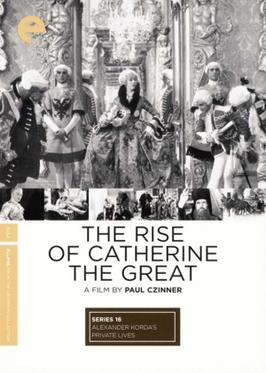
The Rise of Catherine the Great is a 1934 British historical film about the rise to power of Catherine the Great. It was directed by Paul Czinner, and stars Elisabeth Bergner as Catherine, Douglas Fairbanks, Jr., as Grand Duke Peter, Dorothy Hale as Countess Olga, and Flora Robson as Empress Elizabeth.

Young Catherine is a 1991 British TV miniseries based on the early life of Catherine II of Russia. Directed by Michael Anderson, it stars Julia Ormond as Catherine and Vanessa Redgrave as Empress Elizabeth.
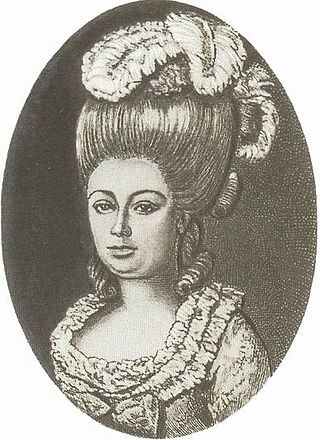
Countess Elizaveta Romanovna Vorontsova was a Russian noblewoman and lady-in-waiting. She was a mistress of Emperor Peter III of Russia. During their affair, rumors suggested that Peter had intentions of divorcing his wife Catherine in order to marry Vorontsova.

Prince Grigory Grigoryevich Orlov was a favourite of the Empress Catherine the Great of Russia, Prince of the Holy Roman Empire (1772), state and military figure, collector, patron of arts, and General-in-Chief.

Marlene Dietrich was a German and American actress and singer.
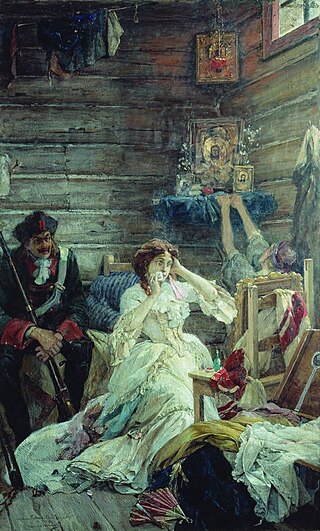
Mary Hamilton, or Maria Danilovna Gamentova, was the lady-in-waiting of Empress Catherine I of Russia and a royal mistress of Tsar Peter the Great of Russia. She was executed for abortion, infanticide, theft and slander of Empress Catherine. She is pointed out as one of the possible inspirations for the song "Mary Hamilton".
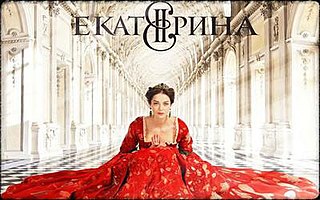
Ekaterina is a 2014 Russia-1 historical television series starring Marina Aleksandrova as the eventual Russian empress Catherine the Great. The first season tells the story of princess Sophie Friederike Auguste, and her rise to power to become Empress of Russia, following a coup d'état and the assassination of her husband, Peter III. The second season portrays the challenges she faces at home and abroad during the early years of her rule, as she tries to revitalise Russia to become one of the great powers of Europe, and becomes titled "the Great".

The Great is a British-American absurdist satirical dark comedy-drama historical fiction television series very loosely based on the rise to power of Empress Catherine the Great of Russia. The series stars Elle Fanning as Catherine and Nicholas Hoult as Emperor Peter III and Peter's body double Yemelyan Pugachev.
